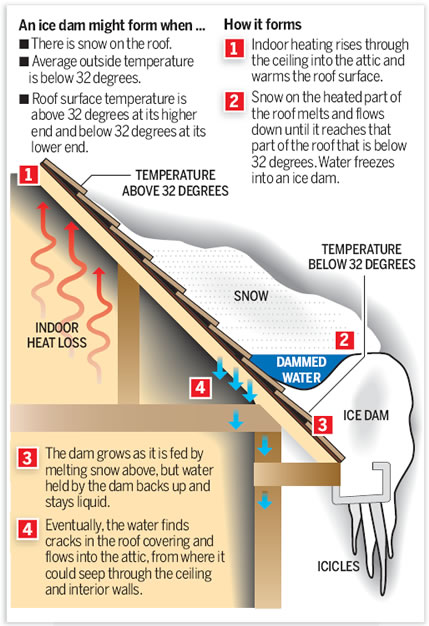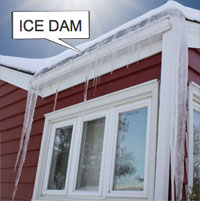Understanding Ice Dams & The Importance of a Quality Roofing System

Diagram used with permission of ALFRED U. ELICIERTO
alfredelicierto@yahoo.ca
Courtesy of The Milwaukee Journal Sentinel
A number of factors can contribute to Ice Dams formation, including (but not limited to):
alfredelicierto@yahoo.ca
Courtesy of The Milwaukee Journal Sentinel
- The orientation of the building
- Amount of tree cover
- Pitch of the roof
- Extreme outdoor temperature fluctuations

Proper use of Ice & Water Barrier Products, plus insulation and ventilation, help prevent ice dams – a major culprit when it comes to roof leaks.
A ridge of ice that forms at the edge of a roof and prevents melting snow from draining off the roof.
Ice dams form when indoor heating rises through the ceiling into the attic and warms the roof surface.
Snow on the heated part of the roof melts and flows down until it meets the part of the roof that is below 32 degrees. At that point, the water freezes into an ice dam.
Water backs up behind the dam and, as it sits on the roof, works its way under the roof covering and flows into the attic. From there it can seep through insulation, ceilings, walls and other areas where it can cause damage.
Keeping a consistent attic temperature can help prevent ice dams. Insulation and ventilation are key components of maintaining the proper conditions in the attic and on the roof deck.
Understanding Roof Ventilation
Learn why proper ventilation, plus the appropriate amount of attic insulation, is crucial to minimizing damage from ice dams and moisture.
Although a quality roofing system is a factor that can help prevent damaging ice dams, it does not guarantee that you will not experience ice dams on your building. At times, an ice dam can become inevitable. Most insurance companies classify ice dam damage as “An Act of God”. Check with your insurance company for more information.

